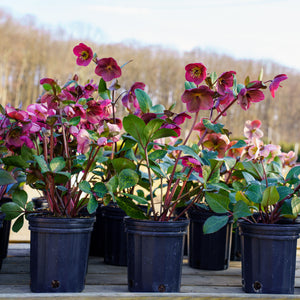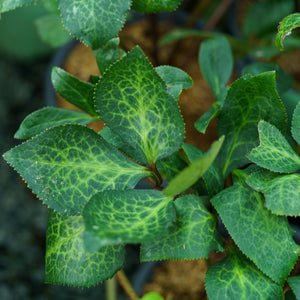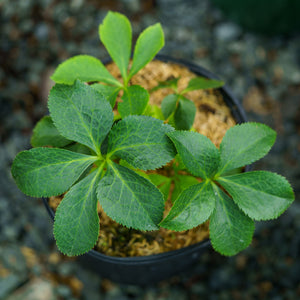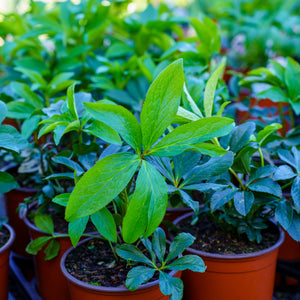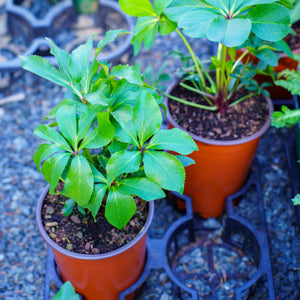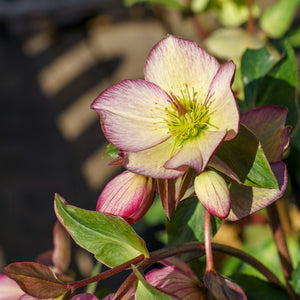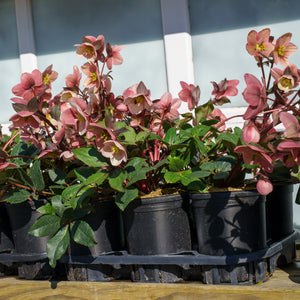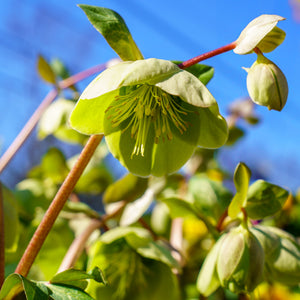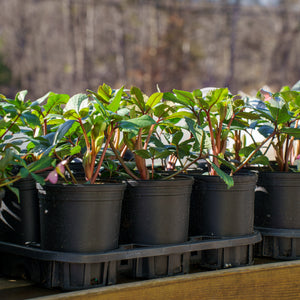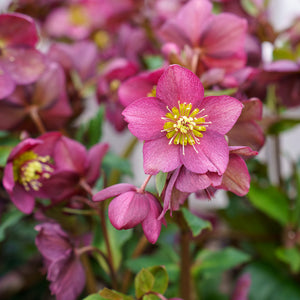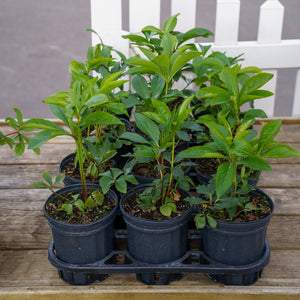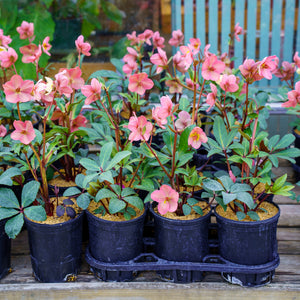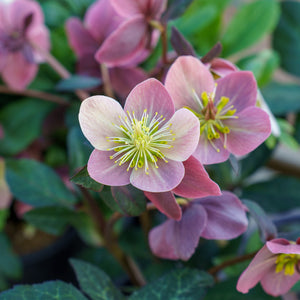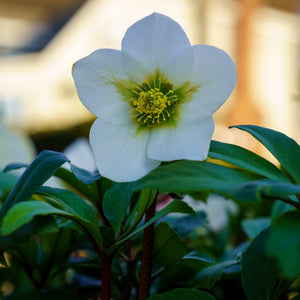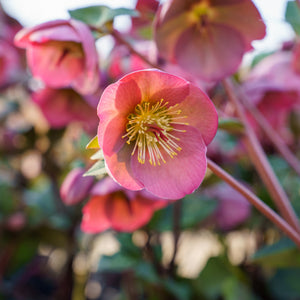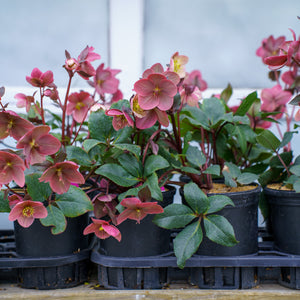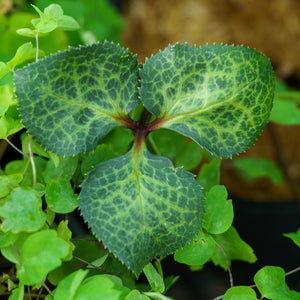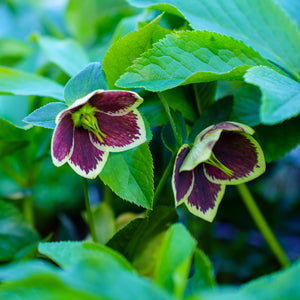The Helleborus Guide
Helleborus, commonly known as hellebores or Lenten roses, are prized for their enchanting blooms and evergreen foliage. These hardy perennials bring a touch of elegance and early spring color to any garden landscape. Known for their ability to thrive in shady and semi-shady conditions, hellebores are perfect for adding texture and interest to borders, beds, and woodland gardens. Their nodding, cup-shaped flowers and lush, leathery leaves make them a favorite among gardeners looking to create year-round appeal. Whether you're seeking to brighten a shaded corner or add early blooms to your garden, hellebores offer a versatile and reliable solution. With minimal maintenance requirements and adaptability to different soil types, hellebores are a hassle-free addition to any garden. Explore our Helleborus Guide to learn more about cultivating and caring for these captivating perennials, and discover how to incorporate them into your garden for lasting beauty and enjoyment.
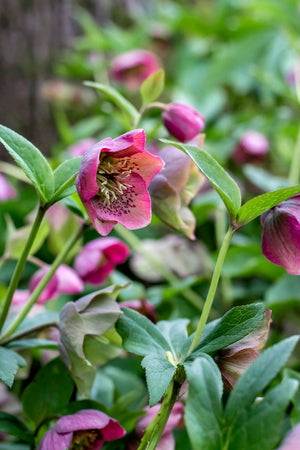
About
Helleborus, commonly known as hellebores or Lenten roses, are part of the Ranunculaceae family. These perennial plants are cherished for their early-blooming flowers and evergreen foliage, providing garden interest at a time when few other plants are in bloom. Native to Europe and Asia, hellebores are well-suited to temperate climates and have become a staple in many gardens worldwide.
Hellebores are characterized by their nodding, cup-shaped flowers that come in a range of colors, including white, pink, purple, green, and even near-black. Some varieties feature speckled or multi-colored blooms, adding to their visual appeal. The flowers typically appear from late winter to early spring, often peeking through the snow, making them a valuable addition to any garden looking for early-season color.
In addition to their beautiful flowers, hellebores have attractive, leathery, evergreen leaves that provide year-round interest. Their foliage forms a dense, clump-forming ground cover that helps suppress weeds and adds texture to the garden.
Hellebores thrive in shaded to partially shaded locations and prefer well-drained, humus-rich soil. They are relatively low-maintenance and are resistant to deer and rabbits, making them an excellent choice for gardens prone to wildlife browsing.
Beyond their ornamental value, hellebores have a rich history in traditional medicine and folklore, although it's important to note that all parts of the plant are toxic if ingested.
Explore the diverse world of hellebores in our comprehensive guide, where you’ll find insights into planting techniques, care practices, and creative uses for these resilient and enchanting plants. Whether you’re enhancing woodland gardens, shaded borders, or mixed perennial beds, hellebores offer timeless beauty and durability to enrich your garden landscape.
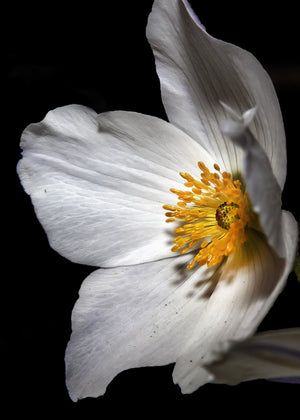
Planting
Helleborus plants require specific planting conditions to ensure their successful establishment and flourishing growth. Here are some essential guidelines for planting and caring for hellebores:
Soil: Hellebores thrive in well-drained, humus-rich soil with a pH level ranging from 6.0 to 7.0. Prepare the planting site by loosening the soil and incorporating organic matter such as compost or well-rotted manure. This enhances soil fertility and drainage, which are crucial for healthy root development.
Sunlight: Hellebores prefer partial to full shade. Choose a location with dappled sunlight or morning sun and afternoon shade. Too much direct sunlight can cause the leaves to scorch, while deep shade might reduce flowering.
Watering: Adequate watering is essential, especially during the initial growth stages. After planting, water the hellebores deeply to ensure the roots receive sufficient moisture. Maintain consistent soil moisture, particularly during dry periods, but avoid waterlogging, which can lead to root rot.
Mulching: Apply a layer of organic mulch, such as leaf mold, compost, or bark chips, around the base of your hellebore plants. Mulching helps retain soil moisture, suppress weed growth, and regulate soil temperature. Keep the mulch a few inches away from the plant stems to prevent rot and fungal issues.
Spacing: Plant hellebores 12 to 18 inches apart to allow for adequate air circulation and room for growth. Proper spacing helps reduce the risk of fungal diseases and promotes healthy plant development.
Planting Time: The best time to plant hellebores is in early spring or fall. Spring planting allows the plants to establish before the heat of summer, while fall planting gives them time to root before winter.
Depth: When planting hellebores, ensure the crown of the plant is at soil level or slightly above. Planting too deeply can hinder growth and flowering.
By following these planting and care instructions, you can ensure the successful establishment and thriving growth of your hellebore plants. With proper attention, hellebores will bring early-season beauty and year-round interest to your garden, enhancing its charm and appeal for years to come.
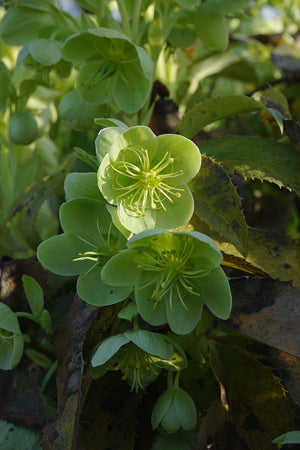
Care
Helleborus plants require specific care to ensure their optimal growth and health. Here are some general guidelines for the care of hellebores:
Watering: During the growing season, provide regular watering to your hellebore plants. Aim to keep the soil consistently moist but not waterlogged. Water deeply at the base of the plant, rather than overhead, to prevent fungal diseases. Adjust watering frequency based on rainfall and weather conditions.
Pruning: Hellebores generally require minimal pruning. Remove any dead or damaged leaves as needed to maintain a tidy appearance and to prevent disease. In late winter or early spring, before new growth begins, cut back any old foliage to make way for new leaves and flowers.
Fertilizing: Fertilizing can help boost the growth and blooming of hellebores. Apply a balanced, slow-release fertilizer in early spring, following the recommended dosage on the product label. Avoid over-fertilizing, as this can lead to excessive foliage growth at the expense of flowers.
Soil and Sunlight: Ensure that hellebores are planted in well-drained, humus-rich soil with a pH level ranging from 6.0 to 7.0. They prefer partial to full shade, making them ideal for woodland gardens or shaded borders. Provide dappled sunlight or morning sun and afternoon shade for the best results.
Mulching: Apply a layer of organic mulch around the base of your hellebores to retain moisture, suppress weed growth, and regulate soil temperature. Use materials like leaf mold, compost, or bark chips, ensuring the mulch does not touch the plant stems directly to prevent rot and fungal issues.
Pests and Diseases: Hellebores are generally resistant to pests and diseases. However, keep an eye out for common issues such as aphids, slugs, and black spot. Inspect your plants regularly and treat any infestations promptly with appropriate organic or chemical controls.
Winter Care: Hellebores are hardy plants that can withstand cold temperatures. In colder climates, protect your plants by applying a layer of mulch to insulate the roots. Remove any snow that may accumulate on the leaves to prevent damage.
Dividing: Hellebores can be divided every few years to rejuvenate the plants and promote vigorous growth. Divide the plants in early spring or fall, ensuring each division has a healthy portion of roots and shoots.
By following these care guidelines, your hellebore plants will thrive and add beauty to your garden for years to come. With their resilience, low maintenance requirements, and stunning early blooms, hellebores are a valuable addition to any landscape, providing color and interest when few other plants are in flower.
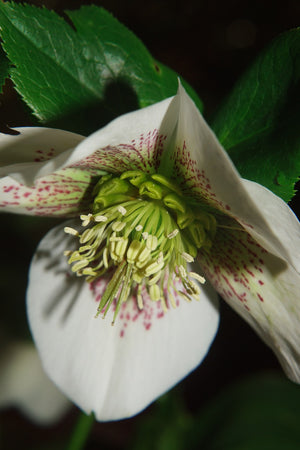
How To Use
Helleborus plants offer versatility and can be utilized in various ways to enhance your landscape. Here are some recommendations based on their characteristics:
Shade Gardens: Hellebores thrive in shaded areas, making them perfect for creating lush shade gardens. Plant them under trees or in areas with dappled sunlight to add color and texture during the early spring when most other plants are still dormant.
Woodland Gardens: Hellebores are ideal for woodland gardens, where they can blend seamlessly with other shade-loving plants like ferns, hostas, and astilbes. Their early blooms and evergreen foliage add year-round interest and beauty to naturalistic garden settings.
Borders and Edging: Use hellebores as border plants along pathways or garden beds. Their low-growing habit and attractive foliage make them excellent choices for defining garden edges and adding a polished look to your landscape.
Ground Cover: Hellebores' dense foliage and spreading growth habit make them effective ground covers. Plant them in groups to cover bare ground, suppress weeds, and create a lush, green carpet that blooms in early spring.
Container Gardening: Hellebores can be grown in containers, adding elegance to patios, balconies, or entryways. Use them in pots or mixed containers to enjoy their flowers up close and bring early-season color to outdoor living spaces.
Mixed Perennial Beds: Incorporate hellebores into mixed perennial beds for continuous seasonal interest. Pair them with spring bulbs, early-flowering perennials, and evergreen shrubs to create dynamic and visually appealing garden compositions.
Cut Flowers: Although hellebores are typically enjoyed in the garden, their blooms can be used in cut flower arrangements. Harvest flowers when they are fully open and display them in vases to bring their beauty indoors.
Naturalizing: Allow hellebores to naturalize in open areas of your garden or woodland settings. Their ability to thrive in shaded conditions and their spreading growth habit make them excellent candidates for naturalistic plantings.
Winter Interest: The evergreen foliage of hellebores provides winter interest in the garden. Plant them in areas where their leaves can be appreciated during the colder months, adding texture and greenery to the winter landscape.
When incorporating hellebores into your landscape, consider their growth habits, sunlight requirements, and soil preferences. By choosing the right placement and utilizing their versatile nature, hellebore plants can enhance the beauty and functionality of your outdoor space, providing year-round interest and seasonal blooms.
Conclusion
Helleborus plants are a captivating and versatile addition to any garden landscape. With their enchanting blooms, evergreen foliage, and ability to thrive in shaded conditions, hellebores bring a touch of elegance and early spring color to your outdoor space. Their ease of care and adaptability make them a favorite among gardeners of all levels. By adhering to proper planting and maintenance techniques, you can fully harness the potential of hellebores to elevate your garden and make a lasting impact.
Whether you seek to create lush shade gardens, woodland retreats, or elegant borders, hellebores can fulfill a variety of roles in your landscape design. Plant them individually to highlight their unique flowers and foliage, or cluster them together for a striking visual display. Hellebores' resilience and adaptability also make them ideal for container gardening, ground covers, and naturalizing in woodland settings.
Beyond their ornamental value, hellebores contribute to the biodiversity of your garden ecosystem by providing early nectar sources for pollinators. Their low maintenance requirements and year-round interest make them an excellent choice for sustainable gardening. With their enduring beauty, versatility, and ecological significance, hellebores bring delight and natural allure to your outdoor environment, enriching your gardening experience and enhancing the overall beauty of your landscape.

